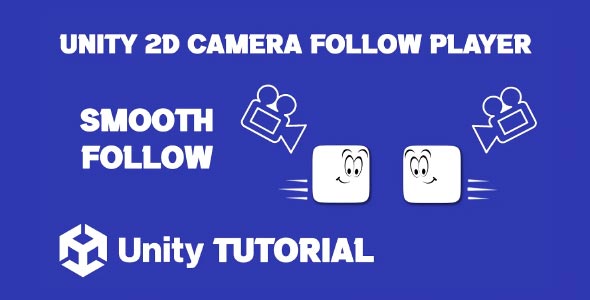Unity 2d camera follow player smooth functionality is one of the core elements that contributes to an engaging and polished 2D gaming experience. Whether you’re building a fast-paced platformer or a slow, exploration-based adventure, having a responsive and fluid camera system is essential. A well-implemented camera that smoothly follows the player adds a professional feel and helps players stay immersed in your world.
In many Unity 2D games, the camera is not just a passive observer. It’s a dynamic tool that adjusts to the player’s movement, reacts to game events, and sets the overall tone for how your game feels. This article explores why a smooth camera system is important, how it enhances player experience, and the best practices for implementing one effectively.
2D Unity Camera Follow Basics
When building your game, thinking about the 2d Unity camera follow mechanic early in development can save a lot of rework later. A jarring or rigid camera can cause discomfort or even motion sickness in some players. On the other hand, a smooth and intuitive camera keeps the player visually connected to the action, especially during rapid movements or transitions.
A common mistake in 2D games is attaching the camera directly to the player, resulting in instant and unnatural movement. This can break immersion and make the game feel unpolished. A better approach involves having the camera ease in and out, lag slightly behind, or even dynamically adjust based on player speed and direction.
It’s also worth considering different camera behaviors depending on the gameplay situation. For example, during combat, you may want the camera to zoom out slightly to reveal more of the battlefield. During exploration, it could tighten up for a more personal and focused experience. These subtle changes contribute significantly to how the game feels moment to moment.
How To Make Camera Follow Player Unity 2D
Learning how to make camera follow player Unity 2d in a way that feels smooth and responsive requires more than just linking camera position to the player. You must account for momentum, player input, and scene layout. A good camera system reacts intelligently to all of these elements, creating a seamless experience.
To build a successful follow system, it’s important to define camera boundaries. This means limiting how far the camera can move in certain directions or how much of the level it should reveal. Boundaries are crucial in side-scrolling games where the environment needs to stay partially hidden or where surprises are part of the level design.
Another useful concept is camera damping. This refers to how gradually the camera moves toward the player’s position rather than snapping to it instantly. By applying a damped, smooth motion, the camera feels more natural and less robotic. This helps create a visually pleasing experience and gives players time to react to changing scenery or hazards.
Why Unity Smooth Camera Movement Matters
Implementing a Unity 2d camera follow player smooth system directly impacts gameplay. For instance, in fast-paced games, such as platformers or runners, the player often needs to make split-second decisions. A jittery or slow camera can make it harder to time jumps or dodge obstacles, leading to unnecessary difficulty and frustration.
In slower-paced games, a smooth camera gives the player time to appreciate the game world. It allows them to take in details, explore at their own pace, and enjoy the atmosphere you’ve created. The camera becomes part of the storytelling, subtly guiding the player’s attention to key areas or moments.
Beyond gameplay, smooth camera motion contributes to a more cinematic presentation. It makes transitions, zooms, and tracking shots feel intentional and well-designed. These moments can add drama, suspense, or excitement, enhancing your game’s emotional impact without relying on dialogue or cutscenes.
Make Camera Follow An Object Unity 2D
Revisiting 2d Unity camera follow, you’ll want to think about how your camera interacts with different terrain types and player actions. For example, if the player jumps or falls, should the camera respond immediately, or should it delay to keep the visual center steady? These decisions shape the player’s sense of control and comfort.
Environmental variety is another factor. As players move through areas with platforms, tunnels, or verticality, the camera must adapt. In some cases, you may want it to anticipate where the player is going rather than only reacting to where they are. This predictive behavior can improve visibility and help players prepare for upcoming challenges.
It’s also smart to test your camera system across different screen resolutions and aspect ratios. A setup that works well in widescreen might feel off in a square or vertical layout. Ensuring consistency across devices guarantees a better experience for a broader audience.
Smooth Camera Follow Object Unity
A second look at how to make camera follow player Unity 2d reveals the importance of feedback and testing. Once you’ve implemented your smooth follow system, observe how players interact with it. Do they seem disoriented during fast transitions? Are there moments when the camera doesn’t keep up with the action? These are clues that your camera behavior needs fine-tuning.
You can also add optional camera effects to increase player immersion. Subtle shakes during explosions, slow zooms during dramatic moments, or slight tilts during movement can all add life to your camera system. Just be careful not to overdo it—these elements should support gameplay, not distract from it.
Player comfort should always be the priority. While it’s tempting to make the camera do stylish tricks, the most important function is always clarity. The player should never lose sight of their character or struggle to interpret what’s happening on screen.
Final Considerations For Camera Design
As you refine your camera follow player system, keep in mind that good camera behavior often goes unnoticed. That’s a good thing. A camera that works well should feel invisible—it simply responds the way players expect. When players focus on the game rather than the camera, you know you’ve done it right.
If your game includes multiple characters, make sure the camera can handle transitions or focus shifts gracefully. For example, during cutscenes or when switching control between characters, the camera should reposition smoothly without sudden jolts.
In multiplayer scenarios, the camera design becomes even more important. Should it center between all players or zoom out as they move apart? The right solution depends on your game’s goals, but in all cases, the key is to maintain visual clarity and player orientation.
Conclusion
Designing a Unity 2d camera follow player smooth system is one of the most rewarding tasks in 2D game development. A well-tuned camera not only tracks the player but enhances the mood, supports gameplay, and brings your game world to life. By focusing on smooth movement, smart boundaries, and responsive behavior, you ensure a more enjoyable and professional experience for your players.
By using the principles behind 2d Unity camera follow, developers can create systems that are adaptable, intuitive, and polished. Camera behavior should never be an afterthought—it plays a central role in how your game feels and flows. The best camera systems are those that make players forget they’re even being followed, letting them stay fully engaged in the moment.
If you’ve ever wondered how to make camera follow player Unity 2d effectively, it all comes down to observation, iteration, and attention to detail. Every game is different, so it’s worth spending time to adjust your camera system to match your game’s pace and style. When done right, it becomes a powerful tool that elevates your entire project.
Script: CameraFollow.cs
using UnityEngine;
public class CameraFollow : MonoBehaviour
{
public Transform player; // Reference to the player's transform
public float smoothSpeed = 0.125f; // Speed at which the camera follows
public Vector3 offset; // Offset from the player's position
void LateUpdate()
{
// Calculate the desired position with offset
Vector3 desiredPosition = player.position + offset;
// Smoothly interpolate between the camera's current position and the desired position
Vector3 smoothedPosition = Vector3.Lerp(transform.position, desiredPosition, smoothSpeed);
// Update the camera's position
transform.position = smoothedPosition;
}
}A smooth camera follow system in Unity 2D helps keep the player in view without jarring movement. It improves game feel and player experience. If your game has multiple areas or scenes, you might also be interested in the Unity 2D Camera Transition Tutorial to learn how to switch between camera views smoothly.


